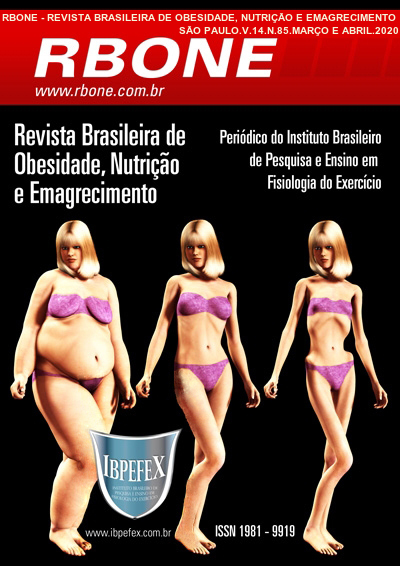Evaluation of saciety in adults through the consumption of a soy chicken product
Abstract
Healthy eating habits and practices are key to maintaining health and human development. The aim of the study was to produce a steak with chicken breast and textured soy protein (steak fiber) and to evaluate the degree of satiety and acceptance of the product after being eaten with a meal. We produce three meals, with the same composition: rice, beans, cooked vegetables, and salad, differentiating only the protein source. We use the grilled chicken fillet proteins, processed steak, and fiber steak. Participants, 21 volunteers, ate all three meals on alternate days, inside sensory analysis booths. Two questionnaires were applied: 1) Immediately after meal consumption (sensory analysis); 2) 120 minutes after meal consumption (satiety questionnaire). The results showed that the inclusion of a protein dish containing higher amounts of fiber and protein can lead to greater satiety in individuals, as shown by steak fiber in relation to chicken fillet in the "How satiated do you feel now?" Questionnaire (p=0.034), as well as the answers in the other variables. About the satiety questionnaire: for the steak fiber group 10 individuals (47.6%) answered completely satiated, while for the other groups this answer was 6 volunteers (28.6%). For the steak fiber group 10 individuals (47.6%) answered being satiated, while 8 (38%) and 4 (19%) satiated for the industrialized steak and chicken fillet groups, respectively. Thus, the consumption of steak fiber can contribute to a greater satiety of individuals.
References
-Arciero, P. J.; Ormsbee, M. J.; Gentile, C. L.; Nindl, B. C.; Brestoff, J. R.; Ruby, M. Increased protein intake and meal frequency reduces abdominal fat during energy balance and energy deficit. Obesity. Vol. 21. Num. 7. 2013. p. 1357-1366.
-Borrajo, K. H. T.; Lima, C. G.; Trindade, M. A. Saciedade subjetiva, aceitação sensorial e aspectos tecnológicos de salsicha com adição de fibra de trigo. Brazilian Journal of Food Technology. Vol. 19. 2016. p. 2-8.
-Brasil. Ministério da Saúde. Secretaria de Vigilância em Saúde. Vigilância de Fatores de Risco e Proteção para Doenças Crônicas por Inquérito Telefônico. Estimativas sobre frequência e distribuição sociodemográfica de fatores de risco e proteção para doenças crônicas nas capitais dos 26 estados brasileiros e no distrito federal em 2016. Brasília: Ministério da Saúde. 2017. 162 p.
-Carvalho, L. T.; Polizer, Y. J.; Baldin, J.; Trindade, M.A. Sensação de saciedade após consumo de hambúrguer bovino com adição de fibra de trigo e reduzido teor de gordura. In: 5º Simpósio de Segurança Alimentar. Bento Gonçalves. Rio Grande do Sul. 2015. p. 1 -4.
-Catalani, L. A.; Kang, E. M. S.; Dias, M. C. G.; Maculevicius, J. Fibras Alimentares. Revista Brasileira de Nutrição Clínica. Vol. 18. 2003. p. 178-182.
-Gentile, C. L.; Ward, E.; Holst, J. J.; Astrup, A.; Ormsbee, M. J.; Connelly, S.; Arciero, P. J. Resistant starch and protein intake enhances fat oxidation and feelings of fullness in lean and overweight/obese women. Nutrition Journal. Vol. 14. Num. 113. 2015. p. 2-10.
-Prefeitura de São Paulo. Secretaria Municipal de Assistência e Desenvolvimento Social. Manual prático para uma alimentação saudável. Prefeitura de São Paulo. 3ª edição. São Paulo. 2015. 92 p.
-Mello, V. D.; Laaksonen, D. E. Fibras na dieta: tendências atuais e benefícios à saúde na síndrome metabólica e no diabetes melito tipo 2. Arquivos Brasileiro de Endocrinologia & Metabologia. Vol. 53. Num. 5. 2009. p. 509-518.
-Souza, M. W. S.; Ferreira, T. B. O.; Vieira, I. F. R. Centesimal composition and functional technological properties of passion fruit rind flour. Brazilian Journal of Food and Nutrition. Vol. 19. Num. 1. 2008. p. 33-36.
-Veldhorst, M.; Smeets, A.; Soenen, S.; Hochstenbach-Waelen, A.; Hursel, R.; Diepvens, K.; Lejeune, M.; Luscombe-Marsh, N.; Westerterp-Plantenga, M. Protein-induced satiety: Effects and mechanisms of different proteins. Physiology & Behavior. Vol. 94. Num. 2. 2008. p. 300-307.
-Westerterp-Plantenga, M. S.; Lemmens, S. G.; Westerterp, K. R. Dietary protein -its role in satiety, energetics, weight loss and health. British Journal of Nutrition. Vol. 108. Num. 2. 2012. p. 105-112.
Copyright (c) 2020 Vitor Antonio Marassi Guariento, Willian Oliveira Silva, Jean Carlos Silvestre

This work is licensed under a Creative Commons Attribution-NonCommercial 4.0 International License.
Authors who publish in this journal agree to the following terms:
- Authors retain the copyright and grant the journal the right of first publication, with work simultaneously licensed under the Creative Commons Attribution License BY-NC which allows the sharing of the work with acknowledgment of the authorship of the work and initial publication in this journal.
- Authors are authorized to enter into additional contracts separately for non-exclusive distribution of the version of the work published in this journal (eg, publishing in institutional repository or book chapter), with acknowledgment of authorship and initial publication in this journal.
- Authors are allowed and encouraged to post and distribute their work online (eg, in institutional repositories or on their personal page) at any point before or during the editorial process, as this can bring about productive change as well as increase impact and impact. citation of published work (See The Effect of Free Access).






